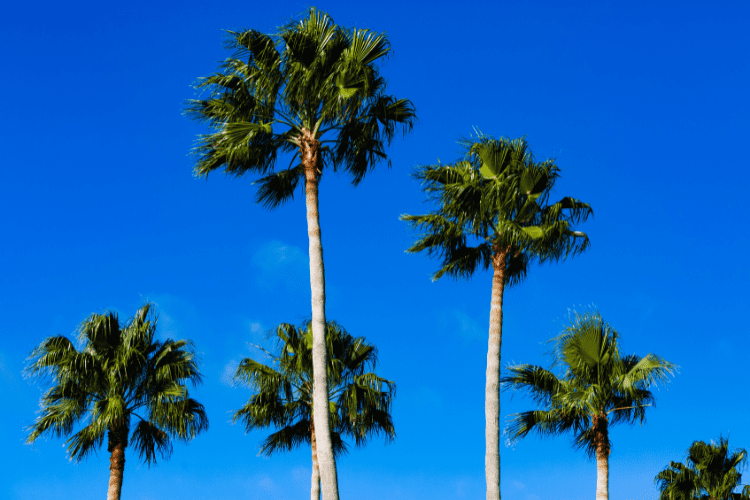- Boxwood Tree Guide: What You Need to Know about Boxwood Shrubs - April 10, 2022
- Hornbeam Tree: All You Need to Know - April 8, 2022
- European Fan Palm: All You Need to Know - March 30, 2022
The Mexican Fan Palm, also called Washington palm, skyduster, or Washingtonia robusta in scientific terms, is a palm tree that grows to about 40-50 feet tall. Sometimes it’ll also grow up to an impressive height of 100 feet. It’s an evergreen fast-growing palm tree that can grow at a rate of around 6 feet annually in the first few years of its life.
The Mexican Fan palm tree can briefly withstand low temperatures down to 20°F, but prolonged cold will bring down even mature palms. The palm tree tolerates drought and poor soil, and thrives in dry, hot urban landscapes, where it impressively stands out in the skyline.
Our Bottom Line Upfront
Fast-growing and cold and drought-tolerant, the Mexican Fan palm (Washington palm, skyduster, Washingtonia robusta) is an evergreen tall palm tree with a single trunk and a fairly small round crown of attractively shaped, rich green, fan-like leaves that are 3-5 feet wide.
Originating in northwestern Mexico and the Baja California peninsula, the palm grows to 40-50 or 100 feet tall and is an incredible accent plant that provides amazing ornamental value in large residential homes and commercial environments.
What’s the Mexican Fan Palm?
The Mexican Fan palm originates in northwestern Mexico’s deserts and is known to be a fast-growing cold hardy palm. This palm tree is popular in large residential and commercial environments. It adds tropical beauty when grown along a wide walkway or a long, winding driveway.
The Mexican Fan palm can be planted throughout the year in sunset zones 8 to 24, as well as USDA hardiness zones 9 to 11, and is a member of the Arecaceae family. It’s also known to be drought and cold-tolerant, which means it can adapt to various types of soil and will flourish in partial shade to full sun conditions.
As mentioned earlier, the Mexican Fan palm can sometimes grow to a majestic height of 100 feet, spreading 10-15 feet wide.
A symmetrical canopy or crown develops when star-shaped fronds spread out from a gray columnar trunk. Lower fronds remain on the palm after they die out, giving this palm tree an untidy appearance.
Star-shaped fronds are dark green, with the leaf blade being 36 inches long and 3-5 feet wide. The trunk has a reddish brown tint, which fades into gray over time. It’s slim and tapered, and will have a diameter of around 2 feet at the bottom and 8 inches at the top when mature.
Mexican Fan palms are planted along long walkways or driveways or as single plants in residential environments.
Due to their huge size, Mexican Fan palms aren’t ideally suited to small backyards or gardens. They’re also at risk of falling over and getting uprooted in areas prone to hurricanes.
How’s the Mexican Fan Palm Used?
The Mexican Fan palm is grown as an ornamental plant, primarily in public or commercial open areas and as a street palm due to its large size, making it unsuitable for most residential environments.
Mexican Fan palms especially make a great spectacle alongside boulevards or against high-rise buildings, when planted at equal intervals and in groups, respectively.
How to Care for the Mexican Fan Palm
Given the fast growth rate of the Mexican Fan Palm, it’s evident that it’s a resilient plant. But that doesn’t mean you shouldn’t take good care of it. Well, here’s to properly look after your Mexican Fan palm.
Planting
First of all, before planting your Washington palm, make sure that the planting area is well-prepared. So choose a place where the palm will receive the full sun and possibly grow to 100 feet tall, without getting in the way of any power line or building in the area.
Moreover, since the palm can grow up to 15 feet wide, be sure to leave around a 25-30 square foot area for the palm’s spread. Next, use a round-point shovel to dig the palm’s planting hole—it should be as deep as the root ball of a young palm and twice its width.
Watering
While the Mexican Fan palm tree is a desert species, it thrives in well-irrigated growing conditions. The palm isn’t super drought-resistant, especially when it’s newly planted. You can plant it in areas with underground surface water.
When planting, make sure to water it with 4-5 gallons to completely drench the soil. However, the palm can definitely survive on less water when it has established itself.
All in all, it’s best to irrigate your Mexican Fan palm moderately in every season save for the winter. In times of colder temperatures, be sure to keep the palm dry. But if you’re unsure of whether you need to re-water the palm or not, dig two inches into the soil with your finger. If the soil appears dry, you should consider re-watering.
Temperature
The growth rate of a Mexican Fan palm is dependent upon the temperature it has to grow in every day.
The palm tree is a cold-hardy variety and quite tolerant to cold weather. In fact, it can survive in USDA hardiness zones 9-11 and can withstand temperatures dipping to 18°F (-8° C). Needless to say, the plant might not survive anything below that.
Fertilizer
Although natural factors are vital to the growth of the Mexican Fan palm, the plant’s nutrition is equally essential to how fast it grows.
So, every couple of months, make sure to feed your Mexican Fan palm with a slow-release palm fertilizer like SUNNILAND All-Natural 6-4-0 in its growth stage. Always go for a water-soluble or granular fertilizer specifically made for the palm, of course, after conducting a comprehensive soil test.
Go for a fertilizer with potassium to help your Mexican Fan palm get stronger and keep diseases at bay, phosphorus to retain nutrients, and nitrogen to encourage photosynthesis so that the leaves keep their green hue. For faster growth during the spring and summer, you can apply a balanced fertilizer with the 8-8-8 formula such as Miracle-Gro® Shake ‘n Feed® Fertilizer.
Sunlight
The rate at which Mexican Fan palm trees grow will depend greatly on the conditions it’s growing in. So, even when it’s able to tolerate partial shade, it’s best to expose it to the full sun for optimal growth.
Soil
Although the Mexican Fan palm can grow in various types of soil, for the best growth rate, you need to plant this palm tree in well-drained fertile soil. The Mexican Fan palm won’t grow healthily in soggy or water-logged soils.
Typically, healthy growth requires a 4 to 1 ratio between native soil and organic compost.
Re-potting
The Mexican Fan palm doesn’t need immediate re-potting. You need to do re-potting just once or twice a year. Of course, considering how fast the Mexican Fan palm grows, it’ll inevitably outgrow the shipped container or original pot. So, each time you re-pot, you need to try to increase the size of the pot by around two inches.
This will be enough to contain the new growth. However, do the re-potting very carefully as there are saw tooth spines at the tip of the leaves. Given the impressive growth of the Mexican Fan palm, it’ll fill up the space you set aside.
Prune and Watch out for Warning Signs
If the fronds of your Mexican Fan palm start going yellow, this could mean it’s been over-watered. In that case, wait until the soil is dry before re-watering the palm. In addition, if the fronds go brown, it could be a sign of an under-watered palm. In that case, make use of a properly-draining potting mixture to balance things.
When the fronds turn yellow or brown, you can prune them to improve the appearance of the palm and allow healthier fronds to thrive.
Keep Pests Under Control
The Mexican Fan palm is a fairly resilient plant, which is quite resistant to disease. However, if you notice aphids, mealybugs, or spider mites near your Washington palm, make sure to tackle them right away as they can hinder the growth of your plant.
To do this, you can simply spray some water on the palm to drive away the pests.
FAQs
Answer: The Mexican fan palm grows fast and can reach 70-100 feet tall, making it unsuitable for typical residential environments.
Answer: Keep your Mexican Fan palm well watered for the first 3 months of its life. Water the palm at the base with a garden hose. After the first 3 months, water the palm sparingly and during hot, dry periods only, since this palm tree is predisposed to rot.
Answer: The Mexican Fan palm resists low temperatures down to 20°F. It’s a popular outdoor and indoor palm with a columnar trunk and small crown at the top, as well as fan-shaped leaves that reach 5 feet long when mature.
Answer: Yes, the Mexican Fan palm tree is invasive in landscape areas, riparian areas, and orchards. It’s commonly planted as an ornamental landscape feature and is shown to build monospecific positions in riparian lands. Also, the palm’s dead fronds are a fire hazard.
Answer: No, the Mexican Fan palm isn’t rooted deeply in the soil. Instead, its roots are spread over soil in a mat-like fashion and penetrate almost 36 inches into topsoil. If the palm’s growing in shallow soil, you can even notice the roots.
The Takeaway on Mexican Fan Palm
The Mexican Fan palm, aka Washington palm, skyduster, or Washingtonia robusta, is a fast-growing, cold hardy, salt-tolerant palm that’s a great choice for coastal areas and beaches.
The palm tree can stand out in commercial or massive residential environments and add a touch of nature to high-rise homes. It’s a perfect addition along streets and for large homes, and can stand out against any city’s skyline.
The Mexican Fan Palm usually grows out of control in most environments with one-story buildings. Thus, it’s recommended that you grow the palm tree alongside other tall trees, including California Fan palms, Date palms, Carolina Cherry’s, Eucalyptus trees, and various desert shrubs and succulents.
Lastly, it’s recommended that you highlight its stunning statuesque look with landscape night lights.





